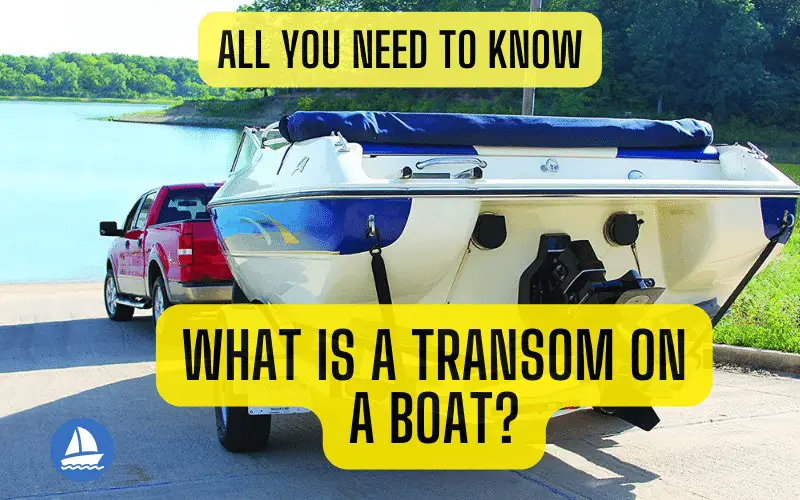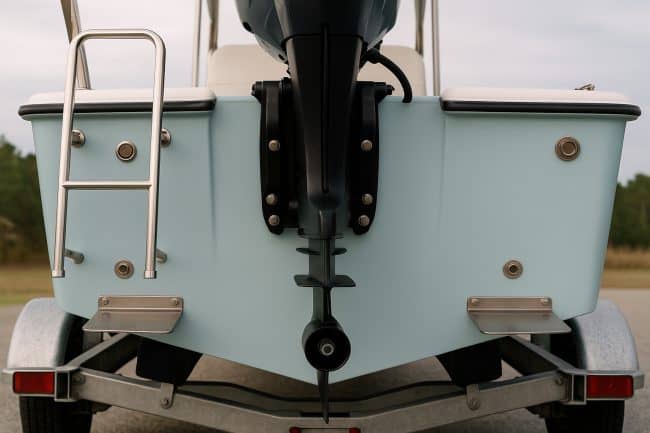What is a transom on a boat? If you’ve spent time around boats or browsed marine forums, you’ve likely come across this term. The transom is not just a structural feature—it’s a critical part of the boat’s design that affects performance, safety, and engine mounting.
The transom is the vertical section at the rear of a boat — the flat or slightly curved surface that forms the boat’s stern. It’s not just a design feature; it plays a significant role in the boat’s structure, handling, and engine mounting.
Understanding the transom is essential for any boat owner or buyer. Whether you’re powering a small fishing boat with an outboard motor or sailing across open water, the condition and configuration of your transom can make a huge difference.
Where Is the Transom Located on a Boat?
The transom is located at the very aft (back end) of the boat, forming the flat wall across the stern. It connects the two sides of the hull and often supports vital elements such as:
-
Swim platforms
-
Ladders
-
Transducers for sonar/fish finders
Transom vs Stern: What’s the Difference?
While the stern refers to the entire rear portion of the boat (including the deck, hull, and fittings), the transom is specifically the vertical or angled surface that seals the end of the hull. Think of the stern as a “zone” and the transom as a key “part” of that zone.
Types of Boat Transoms
Boat transoms vary depending on the boat’s purpose, motor type, and hull design.
Flat vs Curved Transoms
-
Flat transoms are more common in smaller boats, allowing simple engine mounting.
-
Curved transoms offer better hydrodynamics and are usually found on high-end or classic vessels.
Full Transom vs Cut-Out Transom
-
Full transoms span the entire width of the stern and offer more structural integrity.
-
Cut-out transoms have a notch or recessed center to accommodate outboard motors.
Splash Well Transoms
These transoms are common on fishing boats. A splash well is an indented space inside the transom that catches water from waves or motor spray, preventing it from entering the cockpit.
Transoms by Boat Type
-
Fishing Boats often have reinforced flat transoms for outboards.
-
Sailboats typically have raised transoms, sometimes with swim platforms.
-
Pontoon Boats use custom transoms to support single or twin outboards.
What Is the Function of a Boat Transom?
The transom’s job is more than just structural—it supports the boat’s entire propulsion system and plays a critical role in safety and stability.
Structural Support and Engine Mounting
A transom must be strong enough to bear the weight and torque of an outboard motor, especially at high speeds or in rough conditions.
Hydrodynamic Influence
The transom affects how water exits the hull at the rear. A clean, well-angled transom ensures minimal drag and better efficiency.
Towing and Stability
If you tow skiers, inflatables, or other boats, the transom serves as the anchoring point. Poorly reinforced transoms can crack or delaminate under stress.
Common Transom Materials and Their Pros & Cons
Boat transoms can be made from a variety of materials. Let’s look at the most common options:
Fiberglass Transoms
✅ Pros:
-
Durable
-
Lightweight
-
Resistant to corrosion
❌ Cons:
-
Can develop soft spots due to water intrusion
-
Harder to inspect internally
Aluminum Transoms
✅ Pros:
-
Lightweight
-
Rust-resistant
-
Easy to weld
❌ Cons:
-
Prone to fatigue cracking if underpowered
Wood-Core Transoms
✅ Pros:
-
Traditional feel
-
Easy to work with
❌ Cons:
-
High maintenance
-
Susceptible to rot
-
Requires sealing and regular inspection
Composite and Synthetic Core Transoms
✅ Pros:
-
No rot
-
Lightweight and strong
-
Maintenance-free
❌ Cons:
-
Higher cost
-
Harder to modify or repair
Transom Design Considerations for Small Boats
When designing or modifying a transom for a small boat, you need to consider:
Choosing the Right Transom Height
The transom height determines engine shaft length compatibility:
-
15” = Short shaft
-
20” = Long shaft
-
25” = Extra-long shaft
Mismatched heights can cause ventilation or cavitation, reducing performance.
Long Shaft vs Short Shaft Outboards
Always match your outboard to your transom height. Using a long-shaft engine on a short transom will sit the prop too low, causing drag.
Transom Angle & Performance
Most transoms are angled around 12-15 degrees. This angle helps trim the engine and optimize planing. Too vertical or too sloped can hinder boat speed and fuel economy.
Transom Damage and Warning Signs
Like any structural component, transoms are vulnerable to wear and failure.
Common Causes of Transom Rot
-
Unsealed engine mounting holes
-
Water penetration via bolt holes or delamination
-
Prolonged submersion in water
Signs of Transom Damage
-
Soft or spongy feel when pressing the surface
-
Visible cracks around engine mounts
-
Water leaking from screw holes
-
Lowered engine performance or unusual vibrations
How to Reinforce or Replace a Boat Transom
If your transom is compromised, don’t ignore it — it can be a safety hazard.
Can You Repair a Soft Transom?
Yes. Minor rot can be dried, injected with epoxy, or replaced in sections. But complete rebuilds are often safer.
Step-by-Step Boat Transom Replacement
-
Remove outboard motor
-
Cut away fiberglass skin
-
Extract the rotten core
-
Insert new core (marine plywood, composite, etc.)
-
Seal and glass over
-
Reinstall fittings with marine-grade sealant
DIY vs Professional Transom Rebuild
-
DIY: Cost-effective, but requires skill and time
-
Professional: Quicker and warrantied, but expensive ($1,500–$5,000)
Best Transom Mount Accessories and Add-ons
Enhancing your transom setup can boost safety and comfort.
Transom Savers for Trailering
These devices prevent stress on your transom while towing your boat on a trailer by absorbing shock and supporting the motor weight.
Trim Tabs
Mounted near the transom, trim tabs help control boat attitude and efficiency at speed.
Swim Platforms and Ladders
Bolt-on platforms make entering/exiting the boat easier—especially helpful for families and swimmers.
Transom-Mounted Transducers
Fish finders rely on transducers often mounted on the transom for clear sonar feedback.
Boat Transom Maintenance Tips
Here’s how to keep your transom healthy for the long haul.
Keep It Sealed
Use marine-grade sealants around all bolts and screws to prevent water entry.
Regular Inspections
Inspect your transom:
-
Annually
-
After any hard bump
-
If storing boat outdoors
Proper Trailer Support
Avoid bouncing your outboard motor. Always use a transom saver.
Boat Transom FAQs
Can You Mount an Outboard on Any Transom?
No — it depends on transom height, strength, and design.
What Is the Standard Transom Height?
-
15” for short shaft
-
20” for long shaft
-
25”+ for offshore setups
How Long Does a Transom Last?
With proper maintenance, a fiberglass or composite transom can last 30+ years.
Conclusion: Why Understanding Transoms Matters
Your transom does more than finish the shape of your boat — it supports your engine, protects your hull, and impacts your boat’s performance.
Whether you’re buying a boat or replacing a motor, knowing the basics of transom construction, height, and design ensures better decisions on the water. Maintain it well, inspect it often, and your transom will keep you safely afloat for decades.


